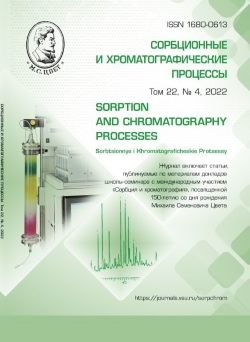Analysis of the composition of extracts of hydrophobic biologically active compounds from medicinal plant raw materials
Abstract
The article presents the results of a chromatographic study of the composition and chemical structure of biologically active compounds (BAC) in solutions obtained by means of extraction of organic compounds from ground calendula flowers (Calendula officinalis L.) and common sage (Salvia officinalis L.) with water in the presence of a hydrochloride of an organic base and a small amount of hydrochloric acid. To determine hydrophobic BACs in aqueous extracts they were extracted with chloroform. The extraction was performed three times. Then the extracts were combined and concentrated by distilling off the solvent under vacuum.
The study was performed using an Agilent 7890BGC System chromatograph with an Agilent 5977AMSD (Agilent Technologies, USA) detector, a HP-5MSUI column and the following phases: 5% of phenyl and 95% of methylpolysiloxane. The carrier gas was helium. Electron impact ionization with a radiation energy of 70 eV was used to obtain the mass spectra. To increase the volatility during the chromatographic analysis of organic compounds whose molecules included mobile protons, we performed silylation of the compounds with trimethylchlorosilane in the concentrate of the chloroform extract. The obtained data was processed and analysed using the NISTII database (19.05.2011) and Mass Hunter. B.06.00 and NISTMS Search 2.0 software packages.
The study determined that aqueous extracts of calendula flowers contained 45 hydrophobic organic compounds (mainly aliphatic aminoalcohols, terpenoids and their metabolites, steroid compounds, aliphatic acids, and hydroxyl-containing aliphatic heterocycles) and extracts of common sage contained 111 hydrophobic organic compounds (mainly terpenoids and their metabolites, derivatives of benzoic acid, aliphatic heterocycles, and steroid compounds).
Downloads
References
Popov E.S., Rodionova N.S., Sokolova O.A., Mazurenko N.Yu. Assessment of the prospects for manufacturing foods from domes-tic plant raw materials balanced in polyunsatu-rated fatty acids. Hygiene and sanitation. 2016; 1: 75-79. (In Russ.)
Butova S.N., Golovanova K.Yu. The use of biologically active substances in the technology of biologically active additives. Food ingredients and biologically active addi-tives in the technologies of food, perfumery and cosmetics. M. MGUPP. 2019, 120-125. (In Russ.)
Alekseeva V.T., Kalgina Yu.A., Razdobarina N.V., Bokarev D.A., Malakova L.A., Yevlakova V.S. Expansion of the range of dairy products through the use of secondary resources. Storage and processing of agricul-tural raw materials. 2017; 10: 37-43. (In Russ.)
Bolotov V. M., Savvin P. N., Koma-rova E. V., Koshevarova I. B. Effect of natura carotenoids and anthocyanins on properties of healthu food products. 2021. IOP Conference Series: Earth and Environmental Science 052001.







